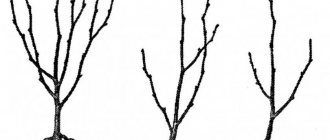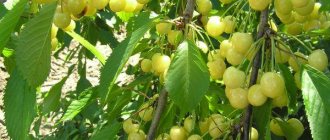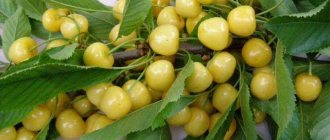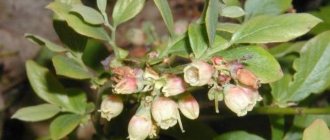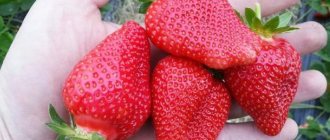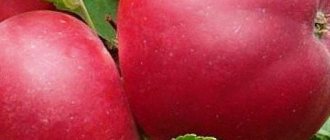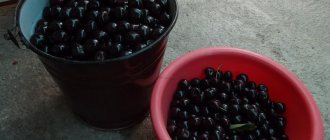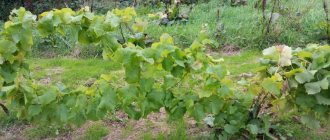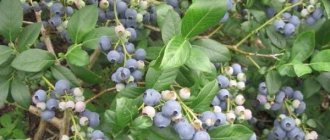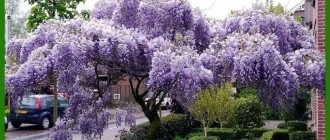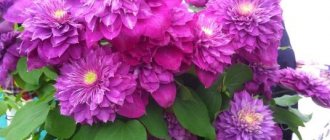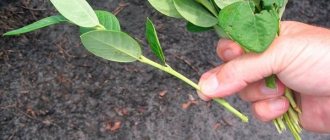History of variety selection
Napoleon is a representative of ancient cherry varieties, bred by European scientists back in the 19th century using the Antipka Magaleb cherry rootstock. In past decades, fruit trees were grown mostly in the southern regions of the Russian Federation, a little later the seedlings came to the city of Khasavyurt (Dagestan), and then the variety spread throughout Russia and today is found in various regions of the state.
Did you know? Regular use of cherries in food reduces the human body's need for sugar. So, with a daily consumption of 100–200 g of such berries, cookies, sweets and other products containing sugar, you will crave much less, which is important when fighting excess weight.
Growing a tree
The tree is self-sterile, so it needs to be planted with other pollinating cherry varieties.
The following types are used in this capacity:
- Drogana yellow;
- Valery Chkalov;
- Jaboulet;
- Kasini is early.
The Black Prince loves sunlight and warmth, does not tolerate stagnation of liquid in the soil and does not like turf areas with an abundance of weeds. Before planting, the soil is dug up, weed control is carried out, and organic fertilizers are applied if necessary.
The hole for such cherries needs to be deep. A layer of fertilizer is added to it.
The root neck of the tree is not deepened into the ground. It should protrude a few centimeters above the soil.
When planting in the fall, the root collar is hilled up and opened after frost. In the northern and central regions, it is optimal to plant cherries in the spring, so that early frosts do not harm the tree. The variety is not winter-hardy, and is capable of fully revealing its positive qualities in the southern regions, but in the black earth regions the yield will be lower.
Botanical description of the variety
The described cherry variety is a representative of the mid-late ripening group, since the trees begin to bear fruit only 4-5 years after the young plant is placed on the site. Up to this point, the growth and development of the plant is characterized by increased intensity, and then decreases slightly.
The height of a ten-year-old plant often reaches 5-6 m, although taller specimens up to 7 m are also found. The crown is of a standard spherical shape, very spreading. The leaf blades are light green, oval and slightly elongated at both ends.
During flowering (usually April), lush white inflorescences form on the shoots, with two or three flowers in each
At the end of flowering, dark red or pink fruits are laid in place of the buds, which weigh at least 5–10 g each when fully ripe. All of them have an elongated oval shape, which in some cases becomes broadly heart-shaped over time. Under the medium-thick skin lies a dense, gristly and very juicy pulp, with a richly sweet taste, sometimes with a slight sourness. The berries reach ripeness in early July, although they are often harvested earlier - at the end of June.
How to care
Even if the cherry was planted on time and in good soil, it still needs to be given attention. It needs to be watered, fed and shaped regularly.
Watering the plant is very important, but it must be done carefully to avoid overwatering. The frequency of watering depends on the stage of tree development and weather conditions.
It is necessary to water the cherries:
- in May, after flowering ends: moisture is needed for fruit development;
- in the first half of June, when the fruits are full: this will help the berries to be juicy and beautiful;
- in dry times: you need to pour it generously, thoroughly saturating the soil;
- in the fall, before the cold weather: moisture is needed to survive the winter safely.
You need to water once every two to three weeks, and more often during drought (every week).
Important! You should not water the cherries during flowering, otherwise the ovaries will fall off, and during the ripening period of the berries, so that they do not crack
Feeding
For the harmonious development of the tree and maximum fruiting, you need to regularly feed the plant with both organic and mineral fertilizers. The feeding mode looks like this:
- organic matter (humus or rotted chicken droppings) is added when digging up the soil around the tree every 2-3 years;
- You can mulch the tree trunk circle with humus or compost: during watering, the roots, along with water, also receive nutritious fertilizer;
- mineral fertilizers containing nitrogen (ammonium nitrate, ammonium sulfate) are applied in the form of liquid in spring (May) and summer (June);
- Phosphorus and potassium fertilizers (buckwheat ash, superphosphate, potassium salt) are fed to the tree in the fall (September): they will give strength for successful overwintering and will help in the formation of buds next spring.
Important! You cannot feed with fresh organic fertilizer (manure): it can cause harm by burning the roots, and will not bring any benefit, since it will take a long time to decompose in the ground. Don't underestimate the importance of tree trunk care
This is essential for the health of the entire tree.
Do not underestimate the importance of tree trunk care. This is essential for the health of the entire tree.
- Each time after watering, you need to loosen the soil to open access to roots, air and moisture.
- It is necessary to destroy weeds, as they “steal” nutrients and interfere with the normal development of a young tree.
- Mulching the soil around the trunk helps retain moisture and prevents weeds from growing. Some gardeners use compost as mulch. Others plant green manure around the tree for the same purpose.
Find out how to make compost with your own hands: in garbage bags, in a compost pit.
Pruning and crown formation
Cherry trees grow intensively, especially in the first years. Therefore, they need to be pruned every year. This should be done in early spring, before the buds swell, or in the fall.
Pruning is carried out in three directions:
- Shortening young annual branches by one-fifth: carried out during the growing years before the tree begins to bear fruit.
- Removing incorrectly growing branches (inside the crown). Thanks to this, a well-lit crown is formed, with each branch being easy to reach.
- Sanitary pruning of dried, frozen and broken branches.
After the procedure, it is necessary to treat the sections with putty: garden varnish, paint or drying oil. This will help speed healing and prevent diseases.
Protection from cold and rodents
Cherry "Napoleon" is quite frost-resistant. But if weather forecasters predict a snowless winter with severe frosts, then it is better to play it safe. By taking the necessary measures, you can protect the tree from freezing and large rodents.
Such measures include:
- whitewashing with lime, which protects the trunk from hypothermia during sudden temperature changes in winter, as well as from insect larvae remaining in the bark;
- wrapping the trunk with various insulation materials (tar paper, rags, pine branches) will serve as protection from frost and from rodents;
- mulching with branches and covering with a snowdrift will insulate the root system;
- insulating the crowns of young seedlings: branches pressed to the trunk are loosely tied and covered with burlap.
Characteristics of the variety
The main characteristics of fruit trees that are of most interest to gardeners were and remain productivity, level of frost resistance, the ability of the plant to pollinate itself, and resistance to diseases and crop pests. For this reason, it makes sense to study these features before planting Napoleon cherries.
Napoleon is a proven cherry variety that has stood the test of time.
Winter hardiness
The winter hardiness and drought resistance of trees of this variety are at an average level, therefore, with stable temperature drops to -30°C, it is better to cover young plants for the winter. For this, artificial or natural materials are used, but always after preliminary treatment of the soil, whitewashing of trunks and other activities related to preparing plants for the winter season.
Important! You should not wrap tree trunks with burlap alone, especially if rodents have been spotted in the area. Trying to protect the plant from the cold, you can attract mice and rats to it, which will negatively affect the condition of the bark and shoots.
Best pollinators
Variety Napoleon belongs to self-sterile plants , which means that in order to form tasty berries you will have to plant pollinating trees in the garden. The best of them are considered to be the varieties Valery Chkalov, Drogana yellow, Zhabule, Cassini early, Early mark. When growing cherries on a mass scale, it is advisable to arrange paired rows.
Large Napoleon cherries are stored for a long time, are transportable, and have excellent characteristics
Productivity and fruiting
With proper organization of care, at least 28-30 kg of berries can be removed from 1 tree, although such results can be achieved no earlier than 5-6 years of growing the grafted young plant. In the southern regions, one 10-year-old tree can produce up to 70 kg of berries, but this is rather an exception to the rule and it is better to focus on the given averages.
Area of application of berries
Ripe Napoleon cherry fruits are excellent for any culinary use, not only fresh, but also dried or frozen. They go well with other berries and fruits, and can also be used when harvesting for the winter. Some gardeners even use the fruits in folk medicine and the culinary industry, which is partly due to their high tasting score of 4.9 out of 5 points.
Napoleon cherries are suitable for winter harvesting
Resistance to diseases and pests
Thanks to the efforts of breeders, Napoleon cherries (both black and pink varieties) are highly resistant to moniliosis, coccomycosis, fruit rot and other fungal diseases , but at the same time suffer from pest attacks. Among insects, trees are afraid of aphids, sawflies and cherry flies, although the latter is less relevant for pink “Napoleonic” cherries.
Advantages and disadvantages of the variety
The advantages of Napoleon cherries are obvious to many gardeners, and to ensure their presence it is enough to simply plant the plant on your site.
- The strengths of the variety are deservedly considered to be the following characteristics:
- high yield rates;
- excellent keeping quality of the harvested crop (berries can be stored in a cool place for up to 2 weeks);
- excellent presentation, and it does not suffer at all even during long-term transportation;
- possibility of universal use (cherries are equally tasty both fresh and after freezing or processing into compotes and preserves);
- comparative ease of crop care.
- As for the disadvantages of growing Napoleon cherries, it is worth remembering:
- average resistance to winter temperature drops;
- the need for the presence of pollinating varieties;
- low resistance to cherry fly.
Pollinators of the Napoleon cherry
Before planting, it is important to know who pollinates the Napoleon cherry. Pollen is carried by the wind, as well as by bees and other insects. Fruiting is possible only in the presence of pollinators. These are cherry varieties that bloom at the same time. If there is not enough free space on the site, then several different varieties are grafted onto one rootstock. Additional conditions for cross-pollination: stable air temperature above 10-15 ° C, absence of heavy rains and heat.
Description of pollinating varieties of Napoleon cherries:
- French black. A productive and winter-hardy cherry variety. The fruits are large, elongated oval in shape. The pulp is dark red, dense, juicy, and has good taste. The variety is resistant to major fungal diseases and produces a consistently high yield.
- Big Star. A new variety of Italian selection. Bears large burgundy fruits weighing from 9 to 12 g. The taste is wine-sweet. The yield is stable and high, about 45 kg of fruit per tree. Cherry is resistant to fungal infections and does not crack after rain.
- Large-fruited. A productive and winter-hardy variety. The fruits are large, weighing 10-16 g, round in shape with a strong dark red skin. The pulp is juicy and fleshy, the taste is sweet and sour. The tree has increased resistance to coccomycosis and moniliosis.
- Drogana yellow. The variety is widespread in Western Europe. The fruits weigh up to 8 g, are yellow in color, have a dessert purpose, and are suitable for processing. Transportability of cherries is low. The variety tolerates drought well. Requires additional protection from cherry flies and gray rot.
Diseases and pests of Napoleon cherries
Pink Napoleon cherry is resistant to the fungus moniliosis, coccomycosis and other diseases. The Napoleon black variety exhibits high immunity to diseases. Preventive spraying, rationing of watering, and pruning shoots help to avoid the spread of diseases. When signs of damage appear (drying of shoots, spots on leaves and fruits), spray with copper oxychloride or Bordeaux mixture. Diseased parts of the tree are first removed.
Advice! Treatments are carried out with caution when forming the crop. Chemicals are not used 3 weeks before harvesting.
The Napoleon variety is susceptible to attack by the cherry fly. Its larvae feed on cherry pulp and severely damage the fruit. The drugs Confidor and Actellik are effective against the pest. Spraying is carried out no more than once every 2 weeks.
Cherry processing Napoleon
When the air warms up to +5 ° C, they begin to process the Napoleon variety. For spraying, prepare a solution of Nitrafen or urea. The product should not come into contact with tree buds. The trunk is also cleared of moss and dry bark, and the cracks are covered with a special paste.
Preparing Napoleon cherries for winter
In late autumn, cherries are watered abundantly. Wet soil freezes more slowly and protects tree roots. The soil is mulched with humus or peat. Young trees are covered with agrofibre and burlap.
Landing Features
Planting any fruit tree begins with choosing a suitable site and proper preparation of planting material, not to mention the rules and technology for performing the planting process itself. Each of these actions has its own characteristics, which should not be forgotten at the stage of planning the procedure.
Did you know? Boiled cherry juice is an excellent remedy in the fight against dry cough, as it helps remove phlegm.
Recommended timing
The optimal time for planting seedlings of the Napoleon variety is mid-autumn, but in accordance with weather conditions. Typically, planting work is carried out at least 2-3 weeks before the expected frost, so that the plants have enough time to fully adapt and prepare for the winter season.
In northern growing regions, with early winters, spring planting will be more preferable, carried out immediately after the snow melts, but before buds appear on the seedlings. With a high degree of probability, this will avoid freezing of the plant root system, but to be on the safe side, you can install a temporary shelter over the seedling.
Video: Instructions for planting cherries
Choosing a suitable location
Cherry is a sun-loving plant, so when choosing a suitable site for placing a seedling, you should give preference to well-lit areas, previously cleared of weeds and plant debris of other crops. About a month before the proposed planting, you should dig up the soil using a spade and, if necessary, fertilize it with organic compounds, at the rate of 4-5 kg per 1 m² of area.
As a result of planting, the root collar of the seedling should protrude above the soil surface by about 3-4 cm , and to prevent it from freezing with the arrival of winter cold, it is worth spudding the young cherries generously, removing the shelter immediately after frost.
When organizing a planting hole, be sure to take into account the dimensions of the root system of prepared seedlings and calculate the depth of the hole, taking into account the thickness of the lower nutrient layer with fertilizers
Selection and preparation of planting material
The best specimens for growing will be Napoleon cherry seedlings on Antipka rootstock, which increases the plant's frost resistance and will also contribute to its better growth and development. Any soil composition is suitable for such planting material, with the exception of very clayey and saline soils.
Find out also about the rules for planting cherry seedlings in the spring.
The root system of plants penetrates to a depth of 4 m, grows shoots more slowly, but at the same time begins to bear fruit earlier. The optimal age of a seedling is 1-2 years, although 3-year-old plants are also allowed for planting, but no older.
A prerequisite when purchasing a Napoleon cherry seedling will be the presence of healthy buds and at least 3 well-developed roots, each 0.2 m long
Of course, before carrying out planting activities, you should carefully examine the prepared cherries for signs of disease development or pest activity, which can be noticeable both on the rhizome and on the aerial parts. The roots and shoots of a high-quality seedling will always be elastic and “alive”, with a uniform surface color. Therefore, if there are a large number of rotten or broken parts, it is advisable to find a more suitable option.
Important! If, when making a cut, the brown inside of the root is visible, it means there has been frost damage and it is better to refuse to purchase such a plant.
Planting scheme
Considering the considerable dimensions of adult cherry trees of the Napoleon variety, it is not surprising that already at the stage of planting seedlings it is worth maintaining a distance of 3-4 m between neighboring plants. All further actions are performed in the following sequence:
- Pour a mound of fertile soil into the prepared hole and lightly level it.
- Drive a support wooden stake into the center.
- Place the selected seedling on the surface and straighten all the roots, carefully cover it with soil, compacting the soil so that there is no free space between the individual roots.
- Tie the trunk to the support stake, leaving the root collar on the surface of the ground and oriented it to the south.
At the end of the procedure, all that remains is to water the young cherries and, if necessary, mulch the tree trunk area with peat or sawdust to maintain a high level of humidity in the thickness of the substrate
Preparing Fatezh cherries for winter
A young tree should be covered for the winter, then the buds and fruit-bearing branches will remain on it, and there will be no need to heavily trim the crown in the spring. It must be remembered that if the bark cracks due to frost, infections will develop in it. Because of this, oxygen must pass through the protection. Therefore, you cannot fill the root collar with manure. Covering cherries is required at a temperature of 0-2 degrees. This is somewhere in late October - mid-November. But if it rains and it becomes warmer, then it is necessary to raise the shelter.
You need to make a frame and stretch a covering material over it - agrospan or spunboy. It is not recommended to use film, since air does not pass through it. To create the frame, slats made of wood or metal are used. It is required to secure the frame at the base with bricks and tie it with rope at the top. In early spring, when the snow has melted, the cover should be removed. A video about Fatezh cherries is below.
Aftercare for cherries
After a short process of planting a Napoleon cherry seedling, a long stage of caring for the plant begins, on which the abundance of fruiting and the quality of the future harvest depend. The main activities in this case will be the following.
Watering and fertilizing
The regime of watering and fertilizing the planted crop depends on the region where the fruit trees are grown. For example, in the southern regions of the Russian Federation, emphasis should be placed on regular moistening of the substrate (especially during dry periods), and fertilizers are usually needed for depleted soils. In this case, you can limit yourself to organic matter in the form of rotted cow manure or plant waste, which is added to the soil mainly in the autumn and soon after the next watering of crops.
In general, the substrate moistening scheme looks like this:
- in May, immediately after the trees bloom, watering is needed for optimal development of already set fruits;
- during the period of filling berries, liquid is important to increase their juiciness and brighter color;
- Before winter frosts, timely moisture-recharging watering will contribute to better frost resistance of plants.
During periods of drought, it is important to moisten the soil well so that the water reaches a depth of 40 centimeters. Surface watering will not bring the desired result, since the moisture simply will not reach the roots of the tree.
The liquid consumption rate for 1 adult plant is at least 40–50 liters of water
Trimming
The process of pruning Napoleon cherries is not much different from similar actions in relation to other varieties of cherries, therefore the general rules apply in this case:
- annual shoots are cut to 1/5 of the trunk length;
- sanitary pruning involves the complete cutting out of all improperly growing branches, dry and damaged specimens.
Both options for the procedure most often occur in the spring, but if absolutely necessary, sanitary cleaning of the crown can be repeated in the fall (after all the leaves have fallen).
Upon completion of the procedure, all large sections should be treated with garden varnish, which is an excellent prevention of diseases and pests, and also promotes faster regeneration of wood tissue
Treatment against pests and diseases
Preventive treatment of cherry trees with insecticidal preparations is rarely carried out, but in case of severe pest infestation (especially cherry weevil), it would be appropriate to spray the crown and trunk with Aktara, Actellik or Enzhio preparations. The solution is prepared in accordance with the available instructions.
We recommend reading about the fight against cherry diseases.
Standard, non-chemical methods of prevention would be timely burning of plant residues and weeds in the tree trunk circle, pre-winter digging of the soil using a shovel, and dosed fertilizing and watering.
With the arrival of spring, during the swelling of the buds, you can spray the trees with a solution of copper sulfate (100 g of the substance is dissolved in a bucket of water)
Photo and description
The German cherry variety is successfully cultivated in warm regions of the country up to the Middle Volga region. This is ensured by two important qualities of Regina - resistance to frost and disease. The tree grows up to 3.5-4 meters, has a crown of medium branching and density.
general description
Regina is classified as an unpretentious variety, therefore it is successfully grown on large farms. Flowering and fruit ripening occur annually. The tree blooms at the end of May, the fruits ripen at the end of July, Regina is a late-ripening variety that ends the cherry season.
Cherries can be stored on the tree for a long time, which is important for busy summer residents; they store well and are transported without loss of taste. The fruits do not leak juice and do not become wet.
Advantages
The list of benefits of the variety is quite impressive:
- taste, beauty and decorativeness of fruits;
- long-term storage without loss of quality, ensured by dry separation;
- annual fruiting of cherries;
- ripe fruits remain on the tree for up to 2 weeks.
Let us also note the very relevant properties of this cherry variety for Russia - winter hardiness and resistance to fungal diseases.
Flaws
Gardeners consider the only disadvantage of Regina to be the need to plant a pollinator, without which it will not be possible to obtain fruits.
Bud
Cherry buds develop late and tolerate frost well at any stage of development. Sawflies are especially dangerous for the buds and can greatly harm the tree.
Leaf and flower
The sheets have a traditional shape - an ellipse, the end is slightly pointed. The edges are serrated. The surface of the plate is glossy and shiny.
The flowers are collected in 2-3 pieces, the petals are white, the cherry blossoms are abundant and friendly.
Fetus
The fruits are round-heart-shaped, evenly and uniformly colored.
Color
Exquisite dark cherry color and shiny glossy skin attract attention to large fruits. The pulp is slightly lighter than the cherry shell
Taste qualities
Regina's taste qualities are close to ideal - score 4.8-5 points. The taste of cherries is sweet, with a slightly noticeable sourness.
Nutrient content
Regina demonstrates all the best qualities of cherries. The berries contain:
- carbohydrates – up to 16%;
- fructose, sucrose;
- vitamins B, C, E;
- potassium, iodine, iron, calcium.
There are no fats in the fruits, the content of pectins is high.
The tree grows up to 3-4 meters, adding up to 50 centimeters annually. The shoots grow upward, which facilitates the formation of the crown.
Flowering and ripening period
Regina begins flowering when most of its relatives have long faded - in mid-to-late May. The fruits also begin to ripen late - in mid-to-late July. If the fruits last a long time, you can eat fresh cherries for most of August.
Productivity
The first cherry harvest is harvested in 3-4 years. A remarkable property of Regina is its annual flowering and fruiting, which does not depend on the vagaries of the weather. An adult tree produces up to 40 kilograms of fruit.
Transportability
Dry tearing allows the fruit to remain firm and whole for up to 3 weeks. The harvest is well stored and can be transported over any distance without losing quality. The dense pulp does not flow, the skin is not injured.
Drought resistance
For successful development at all stages of the growing season, cherries need sufficient moisture. The variety is not considered drought-resistant. Watering is monthly; the soil layer at the roots should be free of cracks and obvious signs of drying out. When the soil dries out after watering, it is loosened.
Disease resistance
Regina is considered one of the most resistant cherry varieties. In humid, cloudy weather, watering is reduced to avoid rot on the fruit.
Application of fruits
The use of fruits is universal:
- the best taste is fresh until mid-August;
- freezing;
- preparing desserts;
- compotes and other types of preservation.
Keeping quality, preservation of taste after transportation and long-term storage make the variety popular in agricultural farms for industrial cultivation.
Basic soil requirements
Cherry grows well in loamy and sandy loam soils. When preparing a site for planting, the soil is enriched to this state. Clay is added to sandy soils; it retains moisture well. Clay soil is combined with river sand to make it lighter and looser.
Any type of soil must be fertilized and mixed with organic matter to provide nutrition to the seedling. It is recommended to prepare the soil in advance, 1-2 years in advance, so that the land acquires fertile properties.
Harvest and storage
At the end of June or beginning of July, you can already begin harvesting Napoleon cherries, removing the berries along with the stalk. When fresh, they can be stored for no longer than 14 days, but even in this case, you will have to place them in a cool place, having first placed them in shallow, spacious containers. For processing for canning, drying or freezing, recently harvested cherries, previously washed and cleaned of dirt, are ideal.
Despite the average frost resistance of Napoleon trees, it is better to plant them in the southern and central regions, where temperature fluctuations are not so significant. Otherwise, these cherries will be an excellent option for the garden, especially if other varieties of this type of fruit tree grow on the site.
How and when to plant
A tree of this variety is extremely demanding of soil and growing conditions. Despite its wide distribution, such cherries do not tolerate wetlands and insufficiently warmed places. If you look at the description of the Iput cherry, then for it, as for the Napoleon variety, the groundwater level should be at least two meters, and the area before planting should be protected from drafts and darkness. The key to good survival of seedlings will be preliminary soil preparation: applying organic fertilizers and ensuring good drainage.
Daibera black cherry variety.
This cherry is widespread in the region. Medium-late ripening, harvested from June 8 to June 17. At 15 years of age it produces 80 kilograms per tree. It begins to bear fruit at the age of 5 years. Winter-hardy, resistant to spring frosts. Resistant to pests, but severely affected by fruit rot. Little suitable for technical processing.
The fruits are large, weight 6.3 grams, beautiful, bluntly heart-shaped, dark red, dense flesh, very good taste.
Valued as a stable, productive and high-quality variety for fresh consumption.
The tree is healthy, with a dense crown, the crown is broadly oval in shape.
Pollinators are Drogana yellow, Cassini early, Ramon Oliva, Aprilka, Gaucher, Golden, Napoleon pink, Franz Joseph, Hedelfingen.
Daibera black itself serves as a good pollinator for the varieties: Aprilka, White from Bordeaux, Gaucher, Drogana yellow, Zolotaya, Cassini early, Napoleon pink, Ramon Oliva, Franz Joseph.
Rules for further care
Before fruiting begins, the seedling needs minimal conditions: watering, weeding and loosening. Around the fifth year of life (or the third after planting), more attention is needed. First of all, spring fertilizing with nitrogen-containing fertilizers is carried out. This is necessary to form the green part. The use of nitrogen together with potassium-phosphorus complexes is not recommended. But how to plant columnar cherries and what varieties there are, reviews from gardeners will help you understand.
Important activities during cultivation:
- Watering is necessary frequently, but moderately, because the plant does not tolerate waterlogging. As the tree grows, the number of waterings is reduced to three times per season.
- Weed control will improve markedly if you mulch the soil at the roots. For the same purpose, green manure plants can be planted in the root area. In addition to the obvious displacement of weeds, after mowing, green manure will provide additional nutrition for the tree.
- Loosening also needs to be done regularly, preferably after each watering. It is necessary to loosen to a depth of no more than 5–7 centimeters so as not to damage the root shoots.
- After harvesting, it is imperative to support the plant with potassium and phosphorus. This promotes the formation of fruit buds for the next year.
- Organic fertilizing can be done throughout the season. For this, peat, humus, and a diluted infusion of manure or chicken droppings are used. On depleted soils, the frequency of fertilizing is increased.
- Pruning is carried out every year. In the spring it is necessary to inspect and remove old and dry branches; the purpose of autumn pruning is to form the crown. To do this, the branches are thinned out in the middle of the crown, and young shoots are shortened by a third of the length they have grown over the year. After pruning, it is necessary to treat the cut estimate with garden varnish to prevent infection.
- Preventive spraying is carried out at the beginning of the season (copper sulfate or Bordeaux mixture). For treatment, special insecticides are used that target a specific problem. Used when necessary. The variety is often affected by the cherry fly, so it is better to have something against it in your arsenal.
- Winter shelter is only necessary in harsh climates, as well as when there is a high risk of a snowless winter. Shoots rarely freeze, but even in this case they quickly recover. Young seedlings are recommended to use crown protection, for which the branches are pressed against the trunk, loosely tied and covered with burlap. For mature trees there is no need to make such a shelter.
It is also worth learning more about how the Bryansk pink cherry tree is grown.
On the video - how to care for cherries:
"Napoleon" is a high-yielding and very resistant cherry. At the moment it is not very widespread, because modern varieties are worthy competition, but in terms of its quality indicators it is a very worthy option. Despite some capriciousness in terms of growing conditions, it takes root well and produces a consistently large harvest. The basic rules for caring for this variety are discussed in our article.
And here you can read reviews about Revna cherries, and learn about the existing description of the variety and about pollinators.
- Nikolai: “Since childhood I remember the taste of this berry. When we visited our relatives in the village, there was a huge tree with almost black fruits. The name is very memorable, and they simply didn’t know what to do with the harvest. Unfortunately, we didn’t find this variety in our nursery, and my plot won’t accommodate such a giant.”
- Valentina: “A neighbor gave me a Napoleon seedling; they have a huge tree and it’s always covered with berries. I am very pleased with the late ripening period, just when the bulk of the cherries have already died. A good variety, very tasty berries, but as for the difficulties in caring for them, I didn’t really notice them. I water, prune and hill up like any other tree. It happens that the berries darken and rot, but rainy weather is more to blame for this.”
